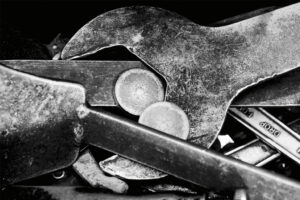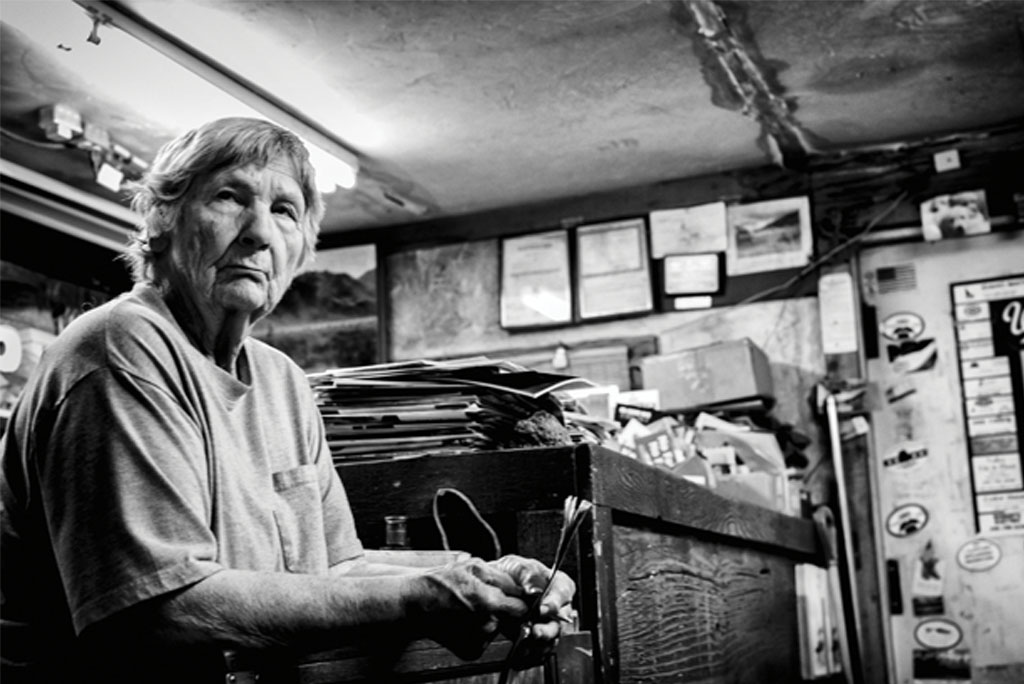When Les Cameron works, the fingers and eyes and arms of generations of Camerons work alongside him. Many hands guide him, reaching back through the years, as he works punching, spreading, flaring, bending, twisting and molding the pieces of metal that make up his craft. It is something that can be felt, like the warming glow of a forge, within the walls of the 77-year-old workshop on Bellevue’s main street.
Les Cameron is a millwright and a welder, wielding the tools of his trade at 216 South Main Street in Bellevue at Wood River Welding. He has been a metal worker since as far back as he can remember. His father, Orville Cameron, was a blacksmith who started the business back in 1945 with his wife Opal and business partner Otis Disbennett, Sr. The original location was across the street in an old livery barn with wooden floors and walls. “You can imagine how difficult that was,” said Les. “They had to wet the floor down every night to stamp out any sparks.”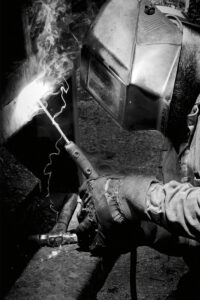
“The second year my father was in business, one of his best customers, Walt Stewart, said, ‘Why don’t you buy land, put up a building and act like you are going to stay,’” said Les. Stewart helped put up some of the money and that is exactly what Les’s father, Orville, did. A neighbor, Joe Shipman, was a stone mason and laid the block, and the main building and warehouse for Wood River Welding was built in 1946. The back building was added in 1978 and a side building and office was added in 1985.
“We only lived a block up the street, so I spent a lot of time in here as a kid, watching,” said Les, who learned his craft almost through osmosis. His father was a blacksmith and metal worker and his older brother, Ed, learned the trade in the Navy and then perfected his skill under the mentorship of his father. Les wanted to be a shop teacher and received his degree from the University of Idaho in industrial arts education, but got most of his knowledge from the college of agriculture and the mechanical engineers. After graduating, he taught school for a year before getting a job dismantling the mill at the Minnie Moore Mine (also known as the Silver Star Queen) in Bellevue, before setting it up again in a tiny town near Council, Idaho—an experience he credits with teaching him how to find solutions in the field. After returning to Bellevue, Les worked in the family business with his parents and brother Ed, until Ed passed from mesothelioma in 2015. He now works with his nephew, Ed’s son Sam, and can still be found, at the age of 76, five days a week at the shop.
As Les walks the warehouse, he moves easily amongst the spirits of those before. Ranch brands are scattered across the massive wooden doors in testament to ranching families and land holdings that have come and gone, even as Wood River Welding remains standing. Hulking machines stand ready and sturdy everywhere in the warehouse. The first that Les lays his hands on is a C-frame open throat hydraulic press. “This one was built right here, on site, designed by Pete Johnson,” said Les, adding that Pete was a WWII veteran who was a self-taught engineer. “He got his G.E.D., learned how to weld in the Navy, then taught himself trigonometry and became one of the best in the business.”
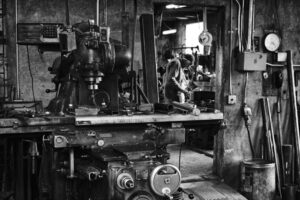 This particular hydraulic press is very rare and might be one of the only one of its kind in the region. Keeping company with it are pipe threaders, milling machines, a coal-fired forge, a large and sturdy Summit drill press, two lathes, and drill bits, grinders, files, nozzles, hammers and power hammers, and saws of all shapes and sizes.
This particular hydraulic press is very rare and might be one of the only one of its kind in the region. Keeping company with it are pipe threaders, milling machines, a coal-fired forge, a large and sturdy Summit drill press, two lathes, and drill bits, grinders, files, nozzles, hammers and power hammers, and saws of all shapes and sizes.
Les recounts the stories of each piece of equipment as if calling up the qualities of old family friends. And indeed they are. One lathe was bought at auction in 1969, an Italian-made beauty Les believes was made around 1958. Another one is a Summit lathe from Yugoslavia, a country that is no longer, even though the machine stands as brawny and solid as a linebacker, rotating and shaping metal workpieces right here in central Idaho.
Each piece of equipment has a story to tell. There are MIG (metal inert gas) welders, several acetylene torches, along with two portable, truck-mounted welders so that Les and Sam can work remotely on-site for customers. There is an Ellis VanSaw to make mitre cuts, a Scotsman Ironworker to help sheer iron and punch holes, and a beloved piece of equipment that Les introduces as the Faye Scot. Clearly, a dear old friend, Les describes the Faye Scot as a lathe picked up at auction by his father more than 35 years ago that probably dates to before 1900.
“It was designed to run off belts in a factory,” Les said. “They took the reverse gear out of a Model-A transmission, mounted the motor right on the machine and made a force feed to change the speed with the lever.”
Wood River Welding is what Les calls a ‘job shop’. “Basically, someone walks in the door with a metal job and we take a look and determine if we can do the job,” Les said. It is work that requires knowledge of the craft combined with the mind to sift through the problem, studying and chewing on different options until finding a workable solution.
“It is becoming a thing of the past,” said Les, who adds that his older brother, Ed, had a good mind for it, figuring out ways to solve problems others couldn’t resolve. “One time, we even worked with Sun Valley Resort fixing a coupling issue tied to their diesel backup system for the big new chairlift,” recalled Les. “We fixed it and ended up working with the guy from Doppelmayr to complete the project.”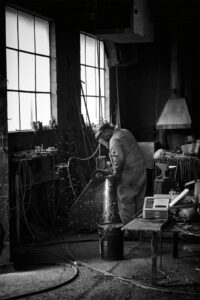
“Each job is different here. You always have to find a new solution to fix what is broken or not working,” said Les. “And that’s a good thing. It keeps it interesting.”
Les and his nephew, and his brother before him and his father before both of them, have created brands for most of the ranches in the region (both his brother and father were excellent blacksmiths), fabricated machine parts and completed essential repair work on farm machinery, construction equipment, chairlifts, snowmaking equipment, engines, and, most recently, a lot of landscaping equipment, pipe and machinery.
Les even worked on creating a medieval sword for Lisle Dye, a Wood River High School student working on her senior project. True to form, Les wanted Lisle to have the full experience of metalworking and the history of welding. Viking warriors used welding techniques and archeologists have discovered iron tools and weapons from ancient cultures like Egypt that have been dated as far back as 1000 B.C. Some of the oldest artifacts known to man were constructed using welding, with small circular boxes made with pressure-welded lap joints being traced as far back as the Bronze Age (3000 and 2000 B.C.).
“If you’re going to make a medieval sword, you need to use medieval tools,” Les instructed his senior project pupil. Using age-old techniques from thousands of years ago, Lisle spent more than 50 hours hammering and pounding and shaping the metal for her sword using an anvil and chisel.
“She was one of my hardest workers,” Les recalled. “Maybe she’ll have a future in the trade.”
